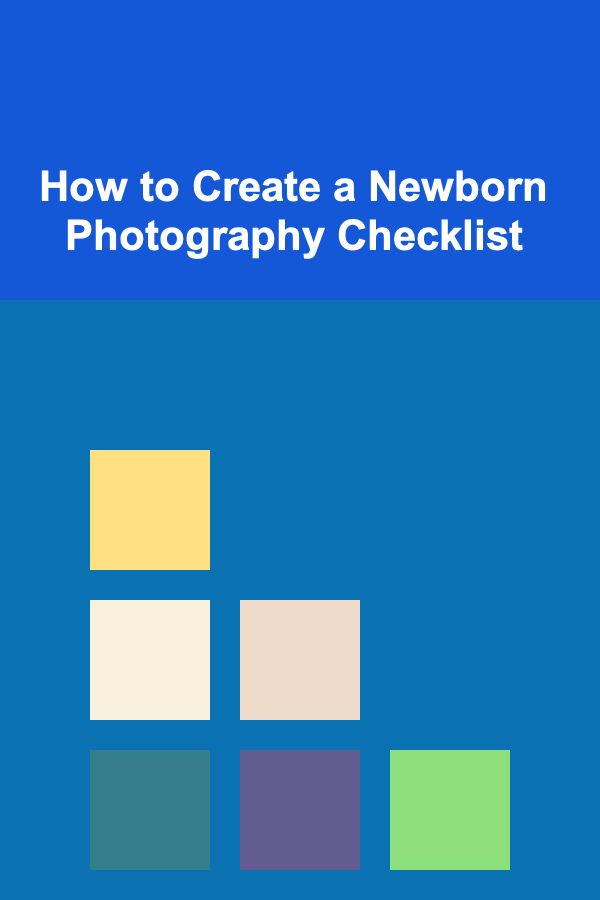
How to Create a Newborn Photography Checklist
ebook include PDF & Audio bundle (Micro Guide)
$12.99$9.99
Limited Time Offer! Order within the next:

Newborn photography is one of the most cherished types of photography, capturing the innocence, purity, and vulnerability of a new life. Whether you're a professional photographer or a parent looking to document your baby's first moments, it's important to be fully prepared. Planning a newborn photoshoot can be a daunting task if you don't have a solid checklist in place.
A well-organized newborn photography checklist ensures that no detail is overlooked, from the right props to the ideal setting and the perfect timing. In this article, we'll explore how to create a comprehensive checklist for newborn photography that will guide you through the entire process, from pre-session preparation to post-session edits.
Pre-Session Preparation
Before you even pick up the camera, preparation is key. Planning ensures that the session goes smoothly and that you're ready for whatever the baby or the situation might throw at you. The following items are essential to consider during this phase:
1.1. Schedule the Session Early
Newborn photos are best taken within the first two weeks of life, as babies are more likely to sleep deeply and curl into those adorable poses. Schedule the session well in advance to ensure you get a time slot when the baby is in the ideal age range.
- Ideal Time: Between 5-10 days old is generally best for posed newborn photos.
- Flexible Timing: Babies can be unpredictable, so allow plenty of time for breaks, feeding, and soothing during the shoot.
1.2. Choose the Right Location
Selecting a location for the shoot can significantly impact the final results. The right location will not only provide a beautiful backdrop but also allow for comfort and warmth for the baby.
- Studio vs. Home: Consider whether you will conduct the session in a studio or the family's home. A studio offers controlled lighting, while shooting at home may have a more personal feel.
- Lighting: Natural light is often the most flattering for newborns, so make sure the location has access to natural light. Consider shooting in the baby's nursery or another room with ample window light.
- Temperature: Keep the room warm (around 80°F or 27°C), as newborns tend to get cold easily, especially during nudity or minimal clothing poses.
1.3. Prepare the Baby
To capture those serene, sleepy moments, a newborn needs to feel calm and comfortable. Here are some tips to prepare the baby for the session:
- Sleep: Newborns are often most relaxed when they're sleepy. Schedule the shoot around the baby's nap times to ensure they're drowsy.
- Feeding: Make sure the baby is well-fed and comfortable before the session. You may need to pause for feeding or diaper changes during the shoot.
- Outfits: If the parents have specific outfits in mind, ask them to bring them, but be sure to have extras on hand just in case. Opt for soft, non-restrictive clothing for the baby.
Props and Accessories
Props add charm and personality to newborn photoshoots. However, it's essential to keep them simple and baby-friendly. Here's a list of items to consider:
2.1. Baskets and Wraps
Soft baskets, bowls, or blankets create cozy settings for newborns. A simple basket with a soft blanket is perfect for those first posed shots.
- Baskets and Bowls: Ensure they're stable and comfortable for the baby to rest in.
- Wraps and Blankets: Opt for soft, stretchable fabrics that won't irritate the baby's skin. Neutral colors or pastel shades work well.
- Safety: Always keep the baby supported. Never pose them in a position where they might fall or be uncomfortable.
2.2. Headbands and Hats
A simple headband or a soft hat can add a cute touch to the photos. Soft, stretchy materials are the best choice to avoid discomfort.
- Soft Hats: Knitted or cotton hats are great for adding texture without overwhelming the image.
- Headbands: Use soft, stretchy headbands with minimal embellishments to keep the focus on the baby's face.
2.3. Personalized Items
Consider incorporating personalized props, such as a name banner, milestone blocks, or custom blankets, to add a unique touch to the shoot.
- Milestone Blocks: These can mark the baby's age or other milestones.
- Personalized Blankets: Parents may have blankets with the baby's name or birth date that could add a sentimental touch.
2.4. Toys and Books
Including toys or books that the parents might want to use in future photos can add continuity. Soft, neutral-colored plush toys work best.
Photographer's Gear Checklist
A successful newborn photoshoot requires more than just great preparation and props; having the right gear is essential. Below is a list of equipment to have on hand:
3.1. Camera and Lenses
Having the right camera and lens will ensure that you capture high-quality images.
- Camera: A DSLR or mirrorless camera with manual controls is ideal for newborn photography.
- Lenses: A 50mm f/1.8 lens is often preferred for portraits, while a 35mm lens works well for wider shots.
3.2. Lighting Equipment
Proper lighting can make all the difference in newborn photography, so it's important to bring the right tools.
- Softboxes or Umbrellas: These help to diffuse light, creating a soft, even look.
- Reflectors: To bounce light back onto the baby's face, reflectors are invaluable.
- Natural Light: If you're working with natural light, consider using sheer curtains to soften the sunlight coming through windows.
3.3. Backup Batteries and Memory Cards
You don't want to run out of power or memory during the session, so pack extra backup batteries and memory cards.
- Multiple Batteries: Newborn sessions can take time, and you don't want to miss a shot because of a dead battery.
- Extra Memory Cards: It's always a good idea to bring at least two or three memory cards.
Safety Considerations
Safety should always be the top priority when handling newborns during photoshoots. While you want to create beautiful images, you also want to ensure that the baby is comfortable and secure.
4.1. Never Leave Baby Unattended
Always have someone present, whether it's a parent or an assistant, to ensure the baby's safety. Never leave the baby alone in a basket, prop, or elevated surface.
4.2. Comfortable Posing
Newborns should never be placed in poses that could cause discomfort or strain on their bodies. Always keep their joints and head supported and be gentle when moving them.
- Avoid Overextending Limbs: Babies are naturally curled up, so avoid forcing them into unnatural positions.
- Safety First: If a pose requires the baby to be unsupported, use a digital composite technique to combine two images for the desired effect, ensuring that the baby remains safe and comfortable.
During the Session
Once everything is set up, it's time to start the photoshoot. Here's what to focus on during the session:
5.1. Keep the Baby Calm
During the session, make sure the baby is calm and comfortable. Soft music or white noise can help soothe them, as can gentle rocking.
- Take Breaks: Newborns can get fussy, so plan to take breaks as needed for feedings, diaper changes, or just some cuddle time.
- Soothing Techniques: Use techniques like shushing, gentle rocking, or swaddling to help calm the baby.
5.2. Capture Details
Newborn photography is all about the little details that make each baby unique. Focus on capturing these precious moments:
- Hands and Feet: Close-ups of tiny hands and feet are an adorable touch.
- Facial Expressions: Even small expressions, like a tiny smile or furrowed brow, add personality to the shots.
- Family Photos: Don't forget to take a few family shots. Parents and siblings often want to be part of the memories.
Post-Session Editing
Once the photoshoot is complete, editing the images properly will help enhance their quality and ensure the best possible results.
6.1. Editing Software
Use professional software such as Adobe Lightroom or Photoshop to edit your photos. Basic adjustments such as exposure, contrast, and color correction are essential.
- Soothing Colors: Soft, pastel tones work well for newborn photography. You can use editing tools to soften skin tones and adjust the warmth of the image.
- Sharpening: Apply minimal sharpening to avoid harshness on the baby's delicate skin.
- Cropping: Cropping out distracting elements can help bring focus to the baby.
6.2. Finalize the Album
After editing, it's time to create a beautiful album or set of prints for the parents to cherish.
- Album Layout: Select the best photos that tell a story, from individual shots to family portraits.
- Print Options: Choose high-quality prints or canvases that will stand the test of time.
Conclusion
Creating a newborn photography checklist is an essential part of preparing for a successful session. By carefully considering the baby's comfort, the props, the location, and the technical aspects of the shoot, you can ensure that the session goes smoothly and that you capture those precious moments that parents will treasure forever. Whether you're a professional or an amateur photographer, following this checklist will help you take beautiful, timeless photos that celebrate the joy of new life.
Reading More From Our Other Websites
- [Small Business 101] How to Leverage Micro‑Influencer Partnerships to Boost Small Business Sales
- [Personal Finance Management 101] How to Start a Side Hustle to Increase Your Income
- [Home Space Saving 101] How to Save Space in Your Bathroom with Smart Storage Hacks
- [Personal Care Tips 101] How to Use Body Butter for After-Sun Care and Skin Repair
- [Home Renovating 101] How to Add Value to Your Home with Simple Renovations
- [Metal Stamping Tip 101] From Concept to Clinic: The Role of Metal Stamping in Modern Medical Instruments
- [Home Rental Property 101] How to Create a Welcoming and Comfortable Rental Space
- [Home Family Activity 101] How to Build the Ultimate Indoor Fort: A Family Guide to Cozy Adventures
- [Home Family Activity 101] How to Build a Family Scrapbook Together
- [Home Maintenance 101] How to Maintain Your Home's Exterior to Boost Curb Appeal

How to Provide Local SEO Services to Small Businesses: An Actionable Guide
Read More
What Are the Best Practices for Organizing Your Craft Room?
Read More
How to Secure AI from Adversarial Attacks
Read More
Developing AR for Healthcare Professionals: A Deep Dive
Read More
How to Create a Road Trip Checklist for Traveling with Pets
Read More
How to Create a Chore Chart for Teenagers: Boosting Responsibility
Read MoreOther Products

How to Provide Local SEO Services to Small Businesses: An Actionable Guide
Read More
What Are the Best Practices for Organizing Your Craft Room?
Read More
How to Secure AI from Adversarial Attacks
Read More
Developing AR for Healthcare Professionals: A Deep Dive
Read More
How to Create a Road Trip Checklist for Traveling with Pets
Read More